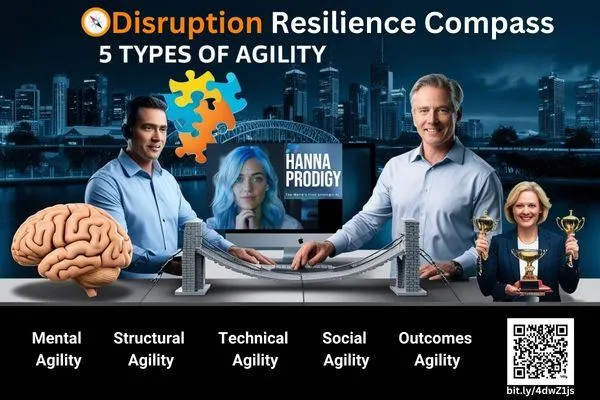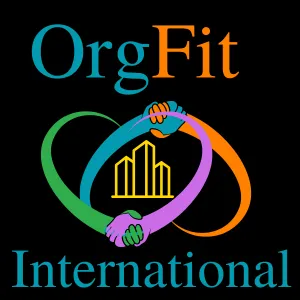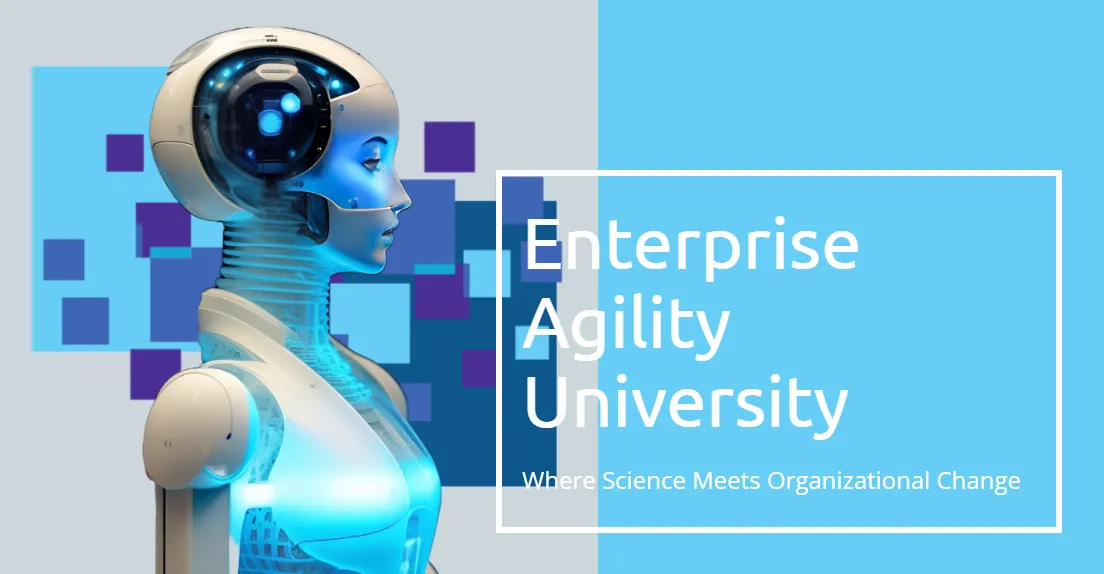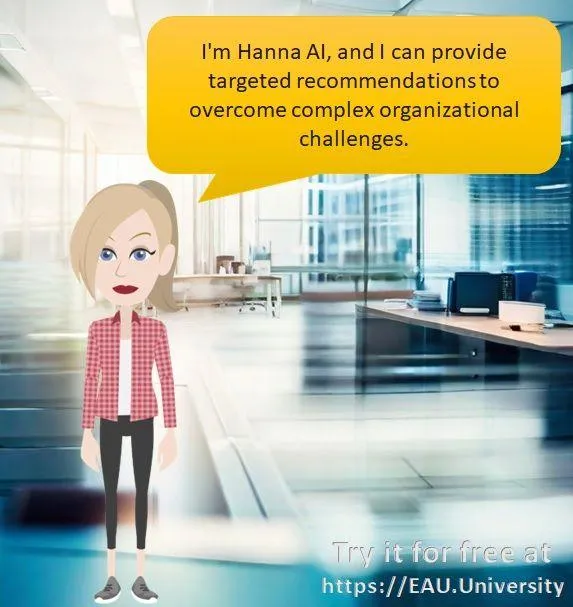Latest OrgFit International Microlearnings
We trust the information you find here will add value and provide you with some valuable steps to manage global disruption and move towards becoming a disruption resilient organization
This weeks Microlearning
Decoding Disruption - Bridging the gap between organization and disruption with the ATOM Model
See the Latest microlearning videos from
OrgFit International
Decoding Disruption - How to Quantum Leap in Disruption
See the Latest microlearning reading from
OrgFit International

Disruption Resilience Compass

A skill set for mastering disruption
"Welcome to our next chapter of sharing disruption insight! Our goal remains the same: to empower organizations and individuals with valuable insights and knowledge about disruption.
In this article we’ll analyze disruption with different sets of lenses or agility hats.
We have already established common ground and understanding of what we understand for disruption, where it comes from, the difference with downturn and disruption, and how to detect where our company is from internal signals and from market signals.
Wow!! such a a trip!!!
A new way of thinking
A profound transformation is underway, requiring a radical redefinition of corporate behaviors for a thriving organization in today's
digital landscape, with a focus on agility, innovation, and human-centered approach.
Imagine a lighthouse standing tall on a rocky coastline, its beam of light cutting through the darkness to guide ships safely to shore. In the same way, a new generation of organizations, such as the Enterprise Agility University, is shining a light on the path to thriving in disruption, illuminating the way for others to follow, by pioneering a new approach to building a culture that's truly fit for the future, leveraging the science behind accelerated change and harnessing the power of AI to guide companies through the challenges of the digital age and towards a brighter future.
The Trivalue Company stands out as a market-leading model for its innovative approach to organizational design. It builds upon existing models, providing a framework for pivoting and adapting to exponential markets.
What sets the Trivalue Company apart is its approach, which is a game-changer for several reasons. Firstly, it doesn't discard previous models, but rather builds upon them, providing new ways of thinking that are suitable for addressing the unique challenges of exponential markets and disruption. This approach allows organizations to pivot and adapt to changing market conditions, leveraging their experience and expertise to inform their decisions.
Secondly, the Trivalue Company provides a practical and actionable framework, embodied in its Trivalue Matrix, which guides organizations through the process of pivoting and adapting. This framework enables companies to gain valuable insights, improve alignment, and make data-driven decisions. By using this framework, organizations can navigate the complexities of exponential markets and make informed decisions that drive success.
Thirdly, the Trivalue Company makes explicit the behaviors and cultural aspects that are essential for success in today's fast-paced business environment. These include enterprise awareness, context awareness, transparency, and adaptability – all of which are critical for building resilience and agility in an organization. By emphasizing these cultural aspects, the Trivalue Company provides a roadmap for organizations to develop the capabilities they need to thrive in a rapidly changing world.
Lastly, the Trivalue Company is driven by three universal outcomes that are essential for any organization operating in a context of extreme uncertainty, such as the digital vortex. These outcomes – always ready, always responsive, and always innovative – provide a compass for organizations to navigate the uncertainty and complexities of the modern business landscape.
By focusing on these outcomes, organizations can develop the agility and resilience they need to succeed in a world that is constantly changing.
The Three Universal Outcomes (TUO) stand out from other well-known business outcomes in their purpose: to ensure long-term sustainability in the face of high uncertainty. Unlike other outcomes that focus on short-term gains, the TUU provides a clear roadmap for behaviors that foster organizational health, a critical factor in navigating rapidly changing conditions.
Think of the TUO as a GPS for decision-making, guiding organizations towards sustainable choices that align with their values and goals. While the Trivalue Company (TVC) ensures equitable prioritization by balancing value among stakeholders, the TUU defines the behavioral results that organizations should monitor to understand the impact of their decisions and drive continuous improvement towards a sustainable future.
The TUO is a game-changer for organizations seeking to thrive in a world of constant disruption. By embracing these outcomes, companies can create a culture that is uniquely equipped to navigate the complexities of the modern business landscape. The TUU provides a clear direction for organizations to focus on the behaviors that matter most, ensuring that they are always ready, always responsive, and always innovative.
For a deeper dive into the TVC and TUO, I recommend checking out Erich Buhler's book, "Fundamentals of Enterprise Agility". This book provides a comprehensive guide to the principles and practices of the Trivalue Company and the Three Universal Outcomes, offering valuable insights for organizations seeking to create a sustainable and thriving culture.
A Three Value Company is not a distinct breed of organization, but rather a company that has undergone a profound cultural transformation. By embracing the principles of the Three Value Company and the Three Universal Outcomes, these organizations have created a culture that is uniquely equipped to thrive in today's fast-paced and disruptive business landscape. The hallmark of a Three Value Company is its ability to demonstrate five distinct levels of agility, which serve as a testament to its commitment to sustainable success and continuous improvement.
Technical Agility
The first level of agility is technical agility, a capability that has been widely adopted by organizations since 2001. At its core, technical agility is about developing software quickly, properly, and cost-effectively. In today's fast-paced business landscape, this capability is crucial for responding to disruption and staying ahead of the competition. With technical agility, your organization can rapidly develop and launch new features, giving your business the customization and flexibility it needs to adapt to changing market requirements in real-time.
Continuous improvement is a key aspect of technical agility, as it enables evidence-based decision making and fosters a culture of experimentation within the organization. This, in turn, allows teams to innovate in a cost-effective manner, driving business adaptability and responsiveness.
One of the key benefits of technical agility is its ability to support affordable innovation. By leveraging the concept of intents, organizations can generate multiple strategic responses to changing market conditions without breaking the bank. This means that businesses can adapt and evolve without sacrificing control over operating costs or impacting prices. In essence, technical agility provides the foundation for organizations to sense and respond to changing market conditions, setting the stage for further agility and innovation.
In practical terms, technical agility enables organizations to respond quickly to changing market conditions, customer needs, and emerging trends. It allows teams to experiment with new ideas, test assumptions, and iterate on solutions in a rapid and cost-effective manner. By doing so, organizations can stay ahead of the competition, drive innovation, and achieve sustainable success in today's fast-paced business landscape.
Overall, technical agility is a critical component of an organization's overall agility, and it provides a solid foundation for achieving sustainable success in today's rapidly changing business environment.
Structural Agility
As agile has evolved, new layers have been added to the team level, enabling organizations to grow and adapt to bigger businesses in a more responsive way. However, with this increased potential has come an increasing complexity too. Structural agility has emerged as a critical component of agility, referring to an organization's ability to change its "layout" effortlessly in response to changing market conditions.
Despite its importance, many companies still struggle to achieve proficiency in structural agility. Failing to do so can have serious consequences during disruption. Even with technical agility in place, slow detection and decision-making can lead to delayed responses, causing businesses to miss opportunities or struggle to innovate. This can ultimately lead to the perception that agility is not delivering the expected outcomes, and its costs may become a concern.
The biggest challenge in achieving structural agility is to truly trust and empower teams to self-organize at scale. This requires a mindset shift, particularly for leaders who may struggle to find their place in this new paradigm. To achieve a leaner organizational structure, companies must look beyond financial metrics and assess various aspects of their operations, workforce, and overall organizational health.
Middle and upper management must develop new skills, such as collective sensing and people mobilizing, to support this new era of agility. By achieving structural agility, organizations can fully exploit their ability to adapt to market conditions, enabling them to capitalize on new opportunities and transform agile into a strategic investment.
With effortless refocusing and redistribution of collective capabilities, organizations can become 'always ready' and 'always responding', aligning with two of the three universal outcomes (TUO). This, in turn, supports the three values that a Three Value Company (TVC) pursues: value for clients through fast responses to their new needs, value for the organization through increased income from new opportunities, and value for workforce wellbeing by reducing stress and cognitive capacity required to adapt.
Outcomes Agility
As agile has evolved, new layers have been added to the team level, enabling organizations to grow and adapt to bigger businesses in a more responsive way. However, with this increased potential has come an increasing complexity too. Structural agility has emerged as a critical component of agility, referring to an organization's ability to change its "layout" effortlessly in response to changing market conditions.
Despite its importance, many companies still struggle to achieve proficiency in structural agility. Failing to do so can have serious consequences during disruption. Even with technical agility in place, slow detection and decision-making can lead to delayed responses, causing businesses to miss opportunities or struggle to innovate. This can ultimately lead to the perception that agility is not delivering the expected outcomes, and its costs may become a concern.
The biggest challenge in achieving structural agility is to truly trust and empower teams to self-organize at scale. This requires a mindset shift, particularly for leaders who may struggle to find their place in this new paradigm. To achieve a leaner organizational structure, companies must look beyond financial metrics and assess various aspects of their operations, workforce, and overall organizational health.
Middle and upper management must develop new skills, such as collective sensing and people mobilizing, to support this new era of agility. By achieving structural agility, organizations can fully exploit their ability to adapt to market conditions, enabling them to capitalize on new opportunities and transform agile into a strategic investment.
With effortless refocusing and redistribution of collective capabilities, organizations can become 'always ready' and 'always responding', aligning with two of the three universal outcomes (TUO). This, in turn, supports the three values that a Three Value Company (TVC) pursues: value for clients through fast responses to their new needs, value for the organization through increased income from new opportunities, and value for workforce wellbeing by reducing stress and cognitive capacity required to adapt.
Social Agility
Social Agility is often seen as the culmination of mastering the previous three layers or eras of Agile. However, it's actually a fundamental enabler that needs to be mastered in order to bring everything together. It's a catalyst that transforms individual skills into collective capabilities, allowing organizations to accommodate the way people connect and share information, leveraging the free flow of ideas and talent redeployment.
The more transparent the culture, the easier it becomes to understand and redefine collaboratively. Social Agility unlocks creativity and motivation, making it an attractive cultural upgrade. However, it's also challenging and hard to maintain, requiring significant efforts in corporate awareness, context sensing, neurodiversity balance, technological investments, and a shared progress approach that may seem counterintuitive to traditional management.
It's understandable that leaving behind skills and habits that have led to past success can be daunting. However, the world has changed drastically, making past and present experiences no longer relevant.
The rules have changed, making it essential to adapt to this new era.
Interestingly, continuous improvement, a fundamental aspect of agility, has its roots in predictive management. It's present in various frameworks like Six Sigma, Lean, CMMI, PMI, and ITIL. However, what if I told you that the current situation is no longer being repeated, and what's true today may not be valid tomorrow? How will continuous improvement help your business make solid progress in such a scenario?
Not having Social Agility exposes your organization to maintaining outdated behaviors and results. Some organizations that have invested heavily in expensive frameworks and dedicated significant time to adopting their practices and roles may be reluctant to start over again.
This is where leadership plays a crucial role. By leading by example, leaders can leverage the power of internal innovation by adopting AI for internal processes and tasks, encouraging teams to automate everything they can, empowering decentralized data-driven decision making, promoting transparency by involving teams in sensing activities that drive strategy, or establishing a quick response room that manages all these aspects.
Outcomes Agility and Social Agility have become essential business skills, rather than just technology approaches. It's no longer just about development teams; it's about thriving in a market where constant disruption is the rule, and uncertainty is cumulative.
Mental Agility
This is the final lens through which we'll observe disruption. If social agility is the catalyst for the other layers, mental agility is the core of social agility. As part of a company-wide agility approach, there's a common ground that every member of the workforce should embrace, regardless of their role or position in the hierarchy.
Beyond the popular 'values and principles' promoted by agile enthusiasts or 'vision and mission' from more traditional approaches, there's something that everyone has in common that enables the rest of any of the layers: mental agility. Defined as the ability to reframe situations effortlessly and analyze them from multiple perspectives, mental agility develops the mindsets and cognitive skills across the workforce that welcome change rather than resist it.
It's the foundation that makes the rest of the layers possible. As you may have noticed, all the previous types of agility depend on being able to analyze the situation and change something, especially beliefs and habits. Mental agility is a matter of every person in the organization. Just like in any team sport, there's no 'I win, you lose' within a single team. Regardless of your role, you should be able to change the way you see reality if needed and evaluate the situation from multiple perspectives to fully understand the whole before taking a shared progress step.
Mental agility enables the enabling factor of the third universal outcome, the 'always innovating'. It allows you to perform a strategic response from the moment disruption hits the organization, with all shared knowledge and collective capabilities aligned. This substantially improves the chances of achieving strategic results with less effort.
By harnessing the benefits of a workforce that welcomes change and values neurodiversity and neuroplasticity, you can create a dynamic and agile organization. This approach can enhance innovation, optimize talent utilization, and foster a culture of continuous optimization and adaptability.
The disruption resilience compass
A Holistic Approach to Mastering Disruption
Regardless of what type of journey your company is on, there is now a wealth of knowledge and experience that can be connected in a simple yet holistic way to master disruption. By combining the Three Value Company (TVC) with the Three Universal Outcomes (TUO) and the 5 levels of agility, you can visualize an ecosystemic landscape of your company, gaining better insights and control points to shape the future of your business.
Resilience now has a framework that enables predictability in times of disruption. As a leader, you have the power to harness this framework and make it your own.
The question is, how will you do it?
Will you use the Resilience Compass to navigate the complexities of disruption and emerge stronger and with more agility?
Will you leverage the TVC and TUO to create a culture of innovation and continuous improvement?
Will you develop the 5 levels of agility to respond to changing market conditions and stay ahead of the competition?
The choice is yours. But one thing is certain: with the Resilience Compass, you have the tools and knowledge to create an organization with the strength of disruption resilience and disruption agility, that can thrive in today's world of constant disruption, fast-paced, and shifting business landscape. So, what's your next move?
Enterprise Agility Microlearnings
from our partner EAU
Moving to a organization to disruption resilience
Embracing disruption
Adaptive Trust, trust needed in disruption
From agile to disruption resilience
The organization bridge to disruption resilience
Equity, Diversity and Neurodiversity to power disruption
Embracing disruption
Enterprise Agility Latest Frameworks and Models
Click here to see all the Enterprise Agility Models, Frameworks and concepts, and while you are there , introduce your self to Hanna your very own free change guru AI at your finger tips.
See the latest Enterprise agility University (EAU) Newsletters
Your Paragraph text goes Lorem ipsum dolor sit a© OrgFit International • Always Ready • Always Responsive • Always Innovative



